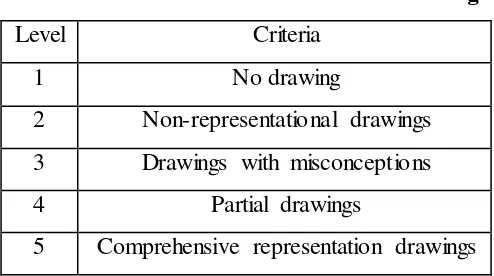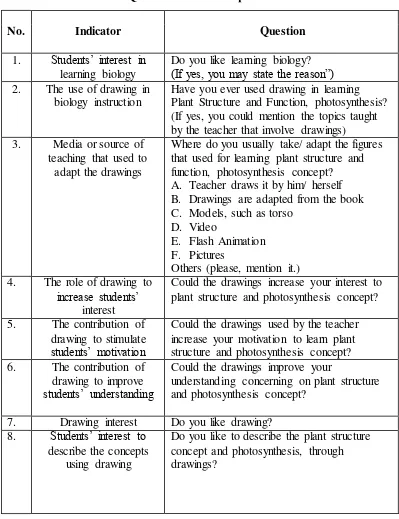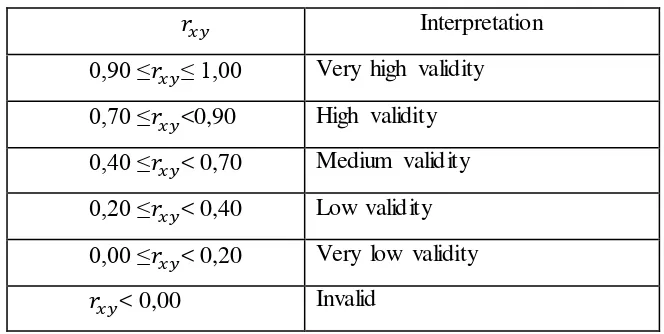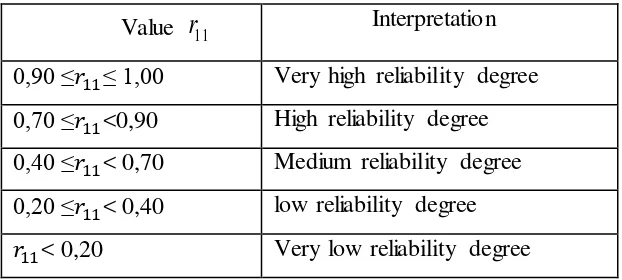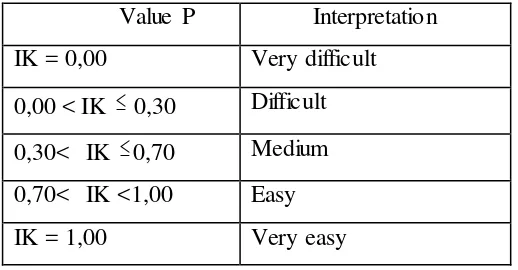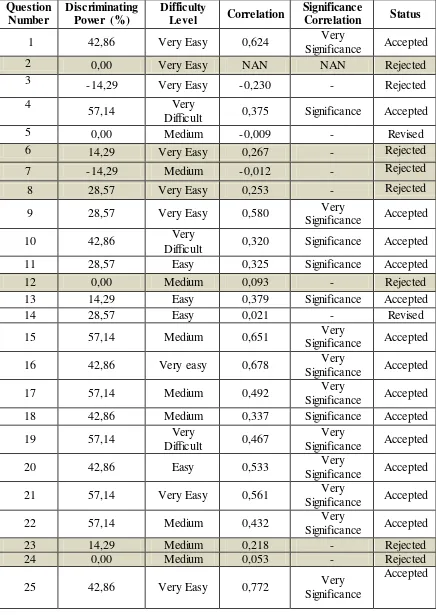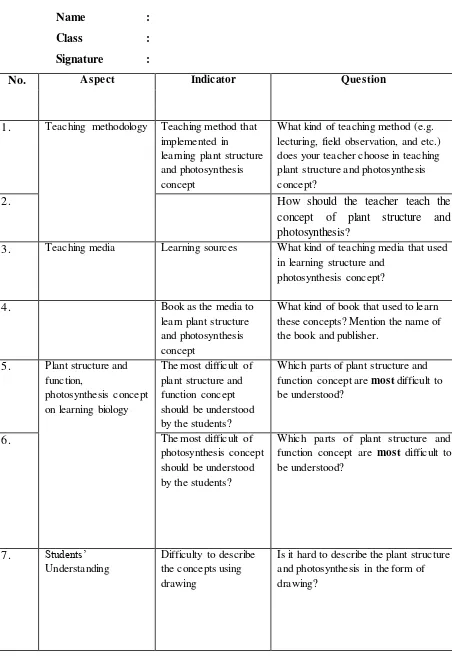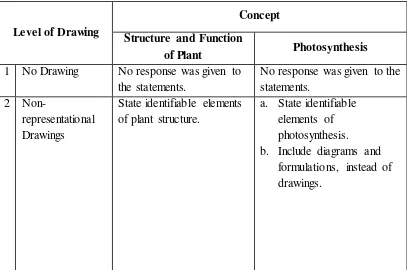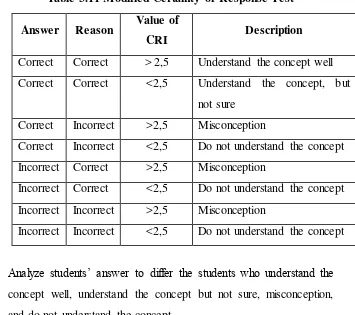CHAPTER III
METHODOLOGY
A. Research Design
The study applied descriptive research method to diagnose students’ misconception about plant structure in relation photosynthesis. According to Best, descriptive research is concerned with how what is or what exists is related to some preceding event that has affected a present condition or event (Cohen et al., 2007). Furthermore, Fraenkel and Wallen (2007) reveal that descriptive studies describe a given state of affairs as fully and carefully as possible.
In this research, the data is gathered using drawing method, while the interview and questionnaire are implemented as the supporting data to complete the study. Then, these data are analyzed and used to describe the current misconception that experienced by the sample of this research.
B. Population and Sample
The location of this research is International Junior High School in Bandung. This school uses English as the formal language of instruction and applies Cambridge Curriculum in combined with National Curriculum of 2013.
C. Operational Definition
In order to avoid misconception about this research, some operational definitions are explained in this study. Those terminologies are described as follow.
1. Misconceptions in plant structure is the number of students’ drawing about root system and shoot system which not aligned with scientific concept and adjusted to the criteria in the rubric scale and interview as the supporting data. The drawing method of this study is based on Köse (2008).
2. Misconception in photosynthesis is the number of students’ drawings that show scientifically incorrect photosynthesis concept and suit to the criteria of drawing with misconception in the rubric scale which based on Köse (2008). In addition, the interview session is applied to support the findings and the analysis of this study.
3. Drawing method that used in this study was developed by Köse (2008) and composed by five level of drawings. The students’ misconceptions are diagnosed based on the third level of drawings which contains spesific criteria to describe students misconception concerning on plant structure in relation to photosynthesis.
D. Research Instrument
In this research, instrument is necessary to be used for gaining idea. These are four types instrument that are used in this research. Those instruments are described below.
1. Drawing Instruction
The drawing instruction is applied to lead the students reflect their understanding about plant structure concept in relation to photosynthesis concept through drawing. This instruction consists of several guided statement related to the concept of plant structure and photosynthesis, which ask the students to draw on the A4- sized paper. The design of drawing instruction is shown in Appendix B1 and B2.
2. Rubric Scale
The rubric scale is used to identify the misconception about plant structure concept and photosynthesis concept that hold by junior high school students. This rubric contains a set of criteria, which categorize the students based on the five levels of conceptual understanding and misconception for these concepts. The design of the rubric scale will be used in this study is the similar rubric that have been used by Köse (2008) and it is shown in Table 3.1. Meanwhile, the modification of Rubric Scale of Drawing is presented in Table 3.10.
Table 3.1 Rubric for Students’ Drawing
Level Criteria
1 No drawing
2 Non-representational drawings 3 Drawings with misconceptions
4 Partial drawings
3. Questionnaire
The questionnaire is arranged to gain the data of students’ interest in drawing and learning biology concept. The open- ended questions will be chosen as the format of the questionnaire. Moreover, the questionnaire provide additional findings about students’ interest in drawing and other information which could be used to support analysis in this research.
Table 3.2 Questionnaire Item Specification
No. Indicator Question
1. Students’ interest in Plant Structure and Function, photosynthesis? (If yes, you could mention the topics taught by the teacher that involve drawings) 3. Media or source of
teaching that used to adapt the drawings
Where do you usually take/ adapt the figures that used for learning plant structure and function, photosynthesis concept? A. Teacher draws it by him/ herself B. Drawings are adapted from the book C. Models, such as torso plant structure and photosynthesis concept? 5. The contribution of
drawing to stimulate students’ motivation
Could the drawings used by the teacher increase your motivation to learn plant structure and photosynthesis concept? 6. The contribution of
drawing to improve students’ understanding
Could the drawings improve your
understanding concerning on plant structure and photosynthesis concept?
7. Drawing interest Do you like drawing? 8. Students’ interest to
describe the concepts using drawing
No. Indicator Question
9. Readability of drawings in teaching media
Are the drawings (e.g. figure) on the book or other teaching media understandable well in learning plant structure and photosynthesis concept?
10. Frequency of drawing usage in describing the
biology concept
Do you often describe the plant structure and photosynthesis concept in the form of
drawing?
4. Item Test in Combined with Certainty of Response Index (CRI)
Besides using drawing method, the students’ misconception about plant structure in relation to photosynthesis will be identified using multiple choice questions with open- reason and Certainty of Response
Table 3.3 Specification of Multiple Choice with Open Reason Item
Concept Number of
relationship with photosynthesis
5, 6, 7, 8, 9, 10 Plant organs and organelles as site of
photosynthesis
11, 12, 13 Components needed for photosynthesis 14, 15, 29, 30
Products of photosynthesis 16, 17, 18, 19,
21, 22, 23
Time when photosynthesis occur 25
General equation of photosynthesis 26
Factors that affect photosynthesis 20, 27, 28
students themselves about beliefs when answering each question. In other words, when learners give CRI, actually provide an assessment of the learners themselves for choosing rules or concepts that have been ingrained in his mind so that they can determine the answer to a question (Hakim et al., 2012).
As a diagnostic test, there are several steps that have been designed to develop this instrument, such as:
a. Determining the standard competency and indicators for item test. b. Constructing the specification of concept that will be used in multiple
choice questions with open- reason. c. Making a draft of instrument.
d. Instrument justification that judged by: 1) Assessments in science education lecturer 2) Plant anatomy experts
3) Science teaching and learning lecturers. e. Try out on students.
After being judged by lecturers and some experts in related field, the instrument should be revised and tried out on another class which had learned the topic before. Based on the test results, the instrument questions will be analyzed with the following requirements:
1) Validity
Anderson, S. B. as quoted in Arikunto (2003) revealed that “A test is valid if it measure what it purpose to measure”. Validity of an instrument is used to measure what it is designed to measure. The aspect that measured through this instrument is cognitive aspect toward plant structure in relation to photosynthesis concept.
The researcher use the Coefficient of Product Moment Karl Pearson to measure the validity of each test item, there is:
∑ [ ∑ ∑ ]
√[ ∑ ∑ ][ ∑ ∑ ]
With, : correlation coefficient between x and y variable n : amount of student
x : total score in test item y : total score of student
Interpretation about will be divided into different categories based on Guilford quoted by Arikunto (2003):
Table 3.4 Classification Validity Coefficient
Table 3.5 Classification of Reliability Coefficient
Value
r
11 Interpretation0,90 ≤ ≤ 1,00 Very high reliability degree 0,70 ≤ <0,90 High reliability degree 0,40 ≤ < 0,70 Medium reliability degree 0,20 ≤ < 0,40 low reliability degree
< 0,20 Very low reliability degree
3) Discriminating Power
Another important procedure in item analysis is calculating the item discrimination power (DP) which can be defined an item test discriminates between high achiever students with low achiever students. Arikunto (2003) to obtain the discrimination power of the items the following formula has been used:
T
RL
RU
DP
2 1
(Arikunto, 2003) Explanation:
DP = Discriminatory power.
RU = The number of tests in the upper group who got the item right.
RL = The number of tests in the lower group who got the item right.
T = The total of tests included in item analysis. Explanation:
11
r
: reliability coefficient
2
i
s : score variant each test item
Table 3.6 Discriminating Power Classification
4) Difficulty Level
A difficulty index will affect the quality of the item test, because an item test which has a low difficulty index (very difficult) probably cause the students desperate and decrease their spirit to solve the problem of the item test (Arikunto, 2003). This case has led the researcher to investigate the difficulty index for each item test. The difficulty index (P) is calculated using the formula below.
JS
B P
Where:
P = Difficulty index
B = students who answer right JS = total amount of students
Arikunto (2003)
Value DP Interpretation
Very poor Poor
Classification of difficulty level in each test item that used is based on Arikunto (2003):
Table 3.7 Coefficient Classification of Difficulty Index
Value P Interpretation IK = 0,00 Very difficult 0,00 < IK
0,30 Difficult 0,30< IK
0,70 Medium 0,70< IK <1,00 EasyTable 3.8 Recapitulation of Multiple Choice Item Test
Difficult 0,375 Significance Accepted
5 0,00 Medium -0,009 - Revised
Difficult 0,320 Significance Accepted
11 28,57 Easy 0,325 Significance Accepted
18 42,86 Medium 0,337 Significance Accepted
Question
29 42,86 Medium 0,365 Significance Accepted
30 14,29 Very Easy 0,323 Significance Accepted
39 57,14 Medium 0,390 Significance Accepted
40 14,29 Medium 0,177 - Revised
5. Interview Guideline
After the drawings is evaluated and categorized according to the criteria above, individual interviews will be conducted among the students with randomly chosen. The purpose was to check the validity of the interpretation of the drawings.
Table 3.9 Interview Guideline
Name :
Class :
Signature :
No. Aspect Indicator Question
1. Teaching methodology Teaching method that
implemented in
learning plant structure and photosynthesis concept
What kind of teaching method (e.g. lecturing, field observation, and etc.) does your teacher choose in teaching plant structure and photosynthesis concept?
2. How should the teacher teach the
concept of plant structure and photosynthesis?
3. Teaching media Learning sources What kind of teaching media that used
in learning structure and photosynthesis concept? these concepts? Mention the name of the book and publisher.
5. Plant structure and
function,
photosynthesis concept on learning biology
The most difficult of plant structure and function concept should be understood by the students?
Which parts of plant structure and
function concept are most difficult to
be understood?
No. Indicator Question
8. When you are asked to draw the
plant structure concept and photosynthesis, have you ever found the difficulties? Could you like to explain it?
9. Reason of the students’
answer
Why do you draw the concept of plant structure and photosynthesis like this
(researcher shows the interviewees’
drawings)?
10. Students’ certainty of
the answer and the drawings
Are you sure with your answer and the drawings?
11. Concept mastery Researcher several questions related to
structure and function of root system and shoot system.
12. Teacher asks several questions
concerning on plant structure and photosynthesis concept, such as:
a. Where are the organelle cells as
the site of photosynthesis?
b. What are the major organs in plant
that take a role as sites for photosynthesis?
c. What are the components needed
for photosynthesis?
d. What are products that resulted
from photosynthesis?
e. When does photosynthesis occur?
E. Data Processing
Data obtained from the students’ drawing, questionnaire, multiple choice questions with open- reason and Certainty of Response Index (CRI), and interview. The detail description of data processing techniques are explained as follows:
1. Drawing Analysis
The students’ drawing of plant structure in relation to photosynthesis concept is analyzed through two steps as follow:
a. Drawing is categorized based on the criteria of level of drawing The concept of plant structure in relation to photosynthesis that has been drawn by the students would be categorized based on the criteria on the level of drawing rubric. The criteria of the rubric is adopted from the rubric that has been developed by Köse (2008).The students’ drawings are categorized into five level of drawing according to the specific criteria as shown in the table below.
Table 3.10 Rubric of Level of Drawing
Level of Drawing
Concept
Structure and Function
of Plant Photosynthesis
1 No Drawing No response was given to the statements.
No response was given to the statements.
2 Non-
representational Drawings
State identifiable elements of plant structure.
a. State identifiable elements of photosynthesis. b. Include diagrams and
Level of Drawing Structure and Function cannot differ petiole and stem; Students draw plant structure and state incorrect function).
a. Show understanding about plant structure. b. Demonstrate some
misconception on the drawings (e.g. students draw the raw materials needed for
incompletely and there is no misconception. For
needed for photosynthesis. 5 Comprehensive elements of plant structure in combined with the
b. Calculation of Students’ Drawing Percentage
After the students’ level of drawing is categorized based on the criteria above, then the percentage for each level of drawing would be calculated using formula as follow:
% Level of Drawing =
2. Questionnaire Analysis
The questionnaire is used to analyze the students’ interest in drawing. This instrument contains a set of questions that could give additional information and findings to support the analysis of students’ misconception about plant structure in relation to photosynthesis. The questionnaire will be processed using a simple formula as follow.
% Students =
3. Certainty of Response Index (CRI) Analysis
Besides using students’ drawing as qualitative data, the identification of students’ misconception about plant structure in relation to photosynthesis concept involves certainty of response index (CRI) which developed by Hasan et al. (1999). Certainty of response index (CRI) is one technique to distinguish the students who understand the concept, misconception, and do not understand the concept (Hakim et al., 2012). In order to analyze the result of CRI data, there are several steps that administered in this research as follow: a. The item test consists of 30 multiple choice questions that
combined with open reason and scale of CRI for each number. b. The category of students’ understanding is determined by the
Table 3.11 Modified Certainty of Response Test
Answer Reason Value of
CRI Description
Correct Correct > 2,5 Understand the concept well Correct Correct <2,5 Understand the concept, but
not sure Correct Incorrect >2,5 Misconception
Correct Incorrect <2,5 Do not understand the concept Incorrect Correct >2,5 Misconception
Incorrect Correct <2,5 Do not understand the concept Incorrect Incorrect >2,5 Misconception
Incorrect Incorrect <2,5 Do not understand the concept
c. Analyze students’ answer to differ the students who understand the concept well, understand the concept but not sure, misconception, and do not understand the concept.
d. The result of students’ understanding category is calculated using a simple formula as follow:
P =
Description:
P : Percentage for each category
4. Interview Result
F. Research procedure
The procedure of this study consisted of following sequential step, which divide into three stages:
1. Preparation Stage
The activities consist of several steps, they are: a. Conducting literature study.
This part is an initial step that conducted to gain actual information related to the theories and research problem. These data could be taken from compatible resource, such as the latest book, journal, articles, and etc.
b. Choose the topic for implementing research.
c. Determine the school as the place to conduct the research. d. Contact the schools and science teacher.
e. Make a permission letter. f. Conducting prior study.
It could be done by examining schools’ archived file about students achievement in science subject and observe how the lesson is conducted in the classroom.
g. Determine the research sample. h. Construct and justify the instrument.
2. Implementation Stage
a. Administration the instrument. b. Analyze the data.
c. Recording misconceptions and identifying students holding those misconceptions.
d. Conducting interviews to the students who hold the misconceptions.
3. Completion Stage
a. Data analysis and data collection b. Draw conclusion
G. Research Plot
Figure 3.12 Research Plot
Problem Identification
Instrument Validation Constructing instrument Choosing topic for conducting the study
Administration the instrument
Recording and identifying students misconceptions
Conducting interviews
Implementation
Stage
Data analysis
Draw conclusion Data processing
Completion
Stage
Determine the sample of research Conducting prior study on students’ misconception about plant structure and
photosynthesis concept
